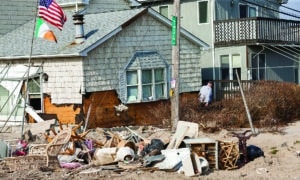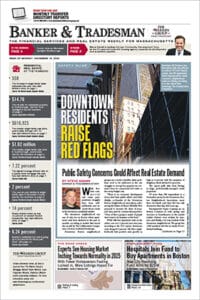
A man walks through the ruins of New York City’s Breezy Point a month after Hurricane Sandy slammed into the city in the fall of 2012. Prospective homebuyers are beginning to react to the risk of climate change-fueled disasters, new research shows.
Homebuyers started to shy away from homes that face the most severe climate risks during the pandemic buying boom, but not as much as might be expected. A challenge in understanding climate change’s impact may be to blame.
Separate research published in the last two months by Zillow and Redfin show that buyers are less likely to pursue a home in areas at high risk for flooding. The Zillow analysis of mortgage data shows that lenders are starting to deny loan applications for some of these homes, too.
But Redfin researchers noted little behavior change among prospective buyers who were looking at only moderately risky homes.
And Zillow found that other climate risks, like flood, heat waves and droughts, didn’t appear to alter buyer or lender behavior last year.
“When you start with the homebuyer, there’s a lot of evidence that they just don’t know,” said Carlos Martín, remodeling futures director at Harvard University’s Joint Center for Housing Studies and a researcher on climate’s impact on housing. “They’re making decisions based on traditional criteria like affordability and schools.”
Change in Behavior Limited
Only homes in “special flood hazard areas” defined by the Federal Emergency Management Agency and purchased with a loan that was then sold to Freddie Mac and Fannie Mae are required to have flood insurance.
But a risk assessment process that’s prey to manipulation by local governments under pressure from residents who didn’t realize they live in an area with flood risk has left as many as 31,000 additional homes in Massachusetts outside those flood areas at risk of inundation, according to 2021 estimates by the First Street Foundation.
“If development has already happened somewhere, it’s hard to tell people not to rebuild,” said Theresa Hatton, executive director of the Massachusetts Association of Realtors.
Redfin’s controlled trial featured 17 million American users who viewed properties flagged as having a “severe” or “extreme” risk of flooding. Buyers with access to flood risk data bid on homes with moderate flood risk scores – a 54 percent reduction on average. The study ran from Oct. 12, 2020 to Jan. 3, 2021 and the results were published in September.
Zillow’s analysis of 2021 nationwide mortgage data found that Census tracts with 10 percent more buildings at risk for flooding saw a 0.23 percent higher mortgage denial rate, a 0.72 percent lower share of mortgage applications for primary homes and a 0.24 percent higher share of applications for investment properties.
Overheated Housing Market a Factor
The major listing portals now offer analysis of properties’ flood and fire risks based on data from organizations like ClimateCheck and First Street, but many states do not mandate disclosure of flood risks, Martín said, limiting what buyers and their real estate agents have historically been able to find out about a property ahead of a sale.
And not a few buyers – especially first-time buyers – have a hard time even evaluating what those risk ratings mean, he added.
The pressure-cooker housing market of the last two years may also have masked some buyers’ concerns, Hatton said.
“It’s a bit like the crazy housing market we’ve been in the last couple of years, where [buyers] have been waiving home inspections. They should have been worried about the condition of the roof or the appliances, but they threw caution to the wind,” she said.
Many Massachusetts buyers higher on the income spectrum, Hatton said, often buy private flood insurance if their first or second home is in a risky location like Cape Ann, Martha’s Vineyard or Nantucket.
“And they may be a little more confident in their ability to recover,” she added.
So far, federal policy has leaned in favor of private-sector efforts to highlight climate risk instead of government efforts, worried about cratering home prices today in areas at risk of future climate disasters. The federal Department of Housing and Urban Development is also developing disclosures for homebuyers covering flood and other climate-related risks.
This leaves it up to municipalities to decide if an area can be built on or what mitigation measures homeowners must take. And it leaves it up to buyers to sort through data from First Street, ClimateCheck and others to determine whether or not they feel comfortable with the predicted risk – a task, Hatton said, that Massachusetts Realtors are equipped to handle.
But middle-class and working-class buyers, said Martín, are often tempted to ignore the risk of flood or fire if the home is affordably priced at a time when fewer and fewer properties are.
“The challenges people need to realize – they have to put themselves in the mind of the homebuyer, where the primary concern is price,” he said.
Lenders Face Actuarial Challenge
Lenders face a slightly different information gap, said Mortgage Bankers Association Chief Economist Mike Fratantoni: turning risk predictions on real estate listing into actuarial data as different companies start offering real estate climate risk products.

James Sanna
Already this year, Black Knight and ATTOM Data Solutions have launched their own risk-analysis data products. ATTOM’s product is focused on both real estate investors and mortgage lenders looking to make sure their loan portfolios have an acceptable amount of exposure to climate risk, Vice President of Product Management Sean Mooney said.
“Relative to a few years ago, there’s a lot more information available to consumers and consumer-facing websites,” Fratantoni said. “You live in a neighborhood next to a forest and the fire risk is heightened, but that doesn’t tell you a lot – you’re not going to get a very clean read that you’ve got a 50 percent chance of a $50,000 loss in the next five years.”
If government regulators do not start mandating how lenders treat climate risk – a proposal from the Securities and Exchange Commission would require public companies to disclose their climate risk to investors, for example – lenders’ behavior will likely start to shift as insurers and reinsurers pull out of certain markets or refuse to cover certain homes, he said. The Gulf Coast is already seeing this happen where the state of Florida is having to step in and backstop local insurance markets.






